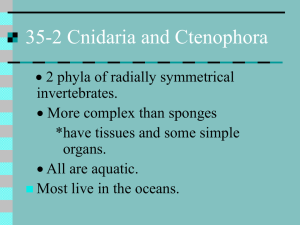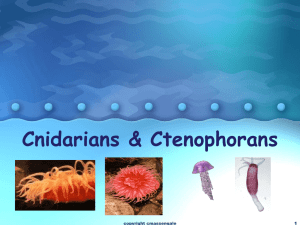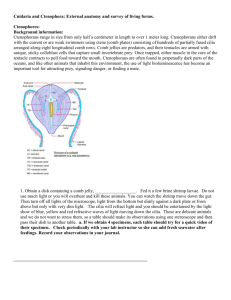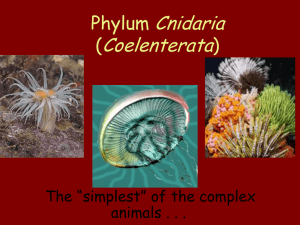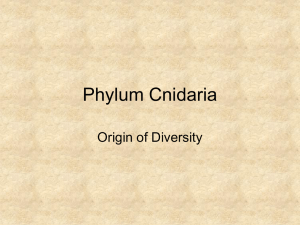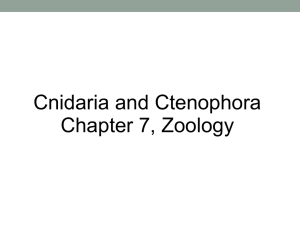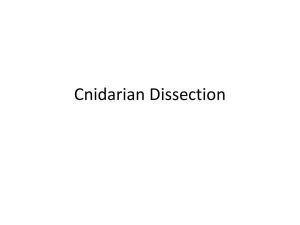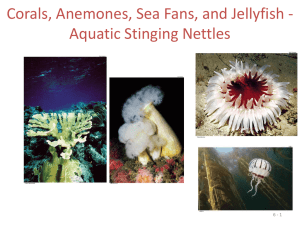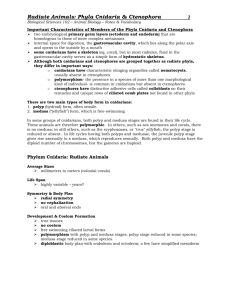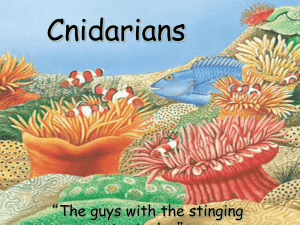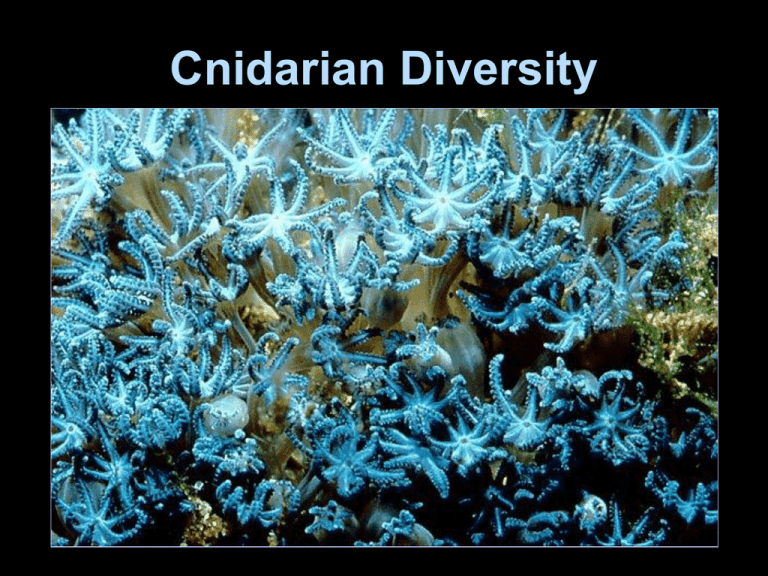
Cnidarian Diversity
Classes of Cnidaria
• Anthozoa
– Anemones and most corals
• Scyphozoa
– Jellyfish
• Hydrozoa
– Hydroids such as Hydra
• Cubozoa
– Cube jellies
Cubozoa
Anthozoa
Scyphozoa
Hydrozoa
Cnidarian Classes
Class:
Hydrozoa
Hydrozoans
• Large class with about 3,000
species
• Life cycle
– Has both polyps and medusae
• Medusae usually solitary, small
– Polyps predominate the life cycle
• Polyps usually colonial
• Habitat
– Mostly marine
– A few freshwater
egg
Sexual
Young
polyp
female
sperm
male
Budding
Hydra
Asexual
Obelia - living
Order Siphonophorae
Siphonophores
Siphonophores
• Order of carnivorous colonial hydrozoans
• About 175 species known
– Most live in deep ocean, so more are being
discovered as deep dive capabilities improve
• Most are active swimmers
• Typically elongate and rope-like,
– some reach lengths of 40 meters or more
• Gelatinous and most disintegrate when
sampled with nets.
Siphonophores
• Siphonophores have elaborated on coloniality
– Unique form of individuality that has led many
scientists to call them ‘superorganisms’.
• Colonial animals consisting of many
multicellular individuals called zooids (zoh –
ids) that are each homologous to solitary
free-living organisms.
– Zooids within a colony are all derived from the
same embryo and are genetically identical
Siphonophores
• Add new zooids through asexual
reproduction, such as budding or fission
– Not followed by physical separation.
– Zooids remain attached and physiologically
integrated.
– There can be a dozen or more functional classes
of zooids in siphonophore colonies
• arranged in precise species-specific patterns.
• pattern is usually reiterated along a linear stem,
• exact same sequence of specialized zooids
repeated
Siphonophores
• Importance of siphonophore colonial structure
– The division labor between siphonophore zooids
parallels the evolution of functional specialization
at other levels of biological organization
• Between cells in a multicellular organism
• Between casts in eusocial insects.
– Wide interest in evolution and developmental
mechanisms involved in this division of labor
• Recognition of self from non-self
• Germ line segregation during development
• Selection within organism – selection of cancer
cell lines
Barrel eye Fish – kleptoparasite
of siphonophores
Macropinna microstoma
Physalia physalis
Physalia physalis
• Portuguese Man of War
– Hydrozoan
– Colony of many specialized polyps
– Deadly sting even when dead on
the beach
– Has symbiotic fish
• Nomeus gronovii (juveniles)
– Feed on Physalia tentacles
and gonads , and may feed
on other jellyfish
Nomeus gronovii
Physalia physalis
• The PortugueseMan-o’-War consists of four
main types of polyp.
– A single polyp forms the large gas-filled float that
sits on the ocean surface and acts as a sail.
– Other polyp types specialise as feeding tentacles
(gastrozooids, of which there are three types),
– as defensive or prey-capturing tentacles
(dactylozooids) and
• Hang to a depth of up to 40 meter,
• Deliver a powerful sting.
– as reproductive organs (gonozooids).
The Portuguese man-o’war,
Physalia physalis, is one of
around 175 species in the order
siphonophores, class Hydrozoa.
It is not a typical member of the
group. While Physalia drifts on
the surface, blown by winds and
carried by currents, most
siphonophores are active
swimmers and live beneath the
surface. A few – the rhodaliid
family – spend their lives tethered
by their tentacles to the sea
bottom. Because of their habitat
and their fragility, siphonophores
are extremely difficult to collect,
and relatively little is known about
them.
Feeding
Polyp
Mouth
First Aid for Physalia Stings
• Do not rub the sting area.
• Remove any adhering tentacles.
• Rinse the area well with sea water (not freshwater).
– NO VINEGAR – can cause more envenomation by a
newly discovered species of Physalia
• Place the stung area in hot water - no hotter than
can be comfortably tolerated.
• If the pain is unrelieved by heat, or if hot water is
not available, apply ice packs.
• Send for medical aid if symptoms persist or
worsen.
Glaucus atlanticus
Glaucus atlanticus
Vellela – By the Wind Sailor
Order: Condrophora
Vellela
Note: pneumatophore divided
into multiple chambers. Only one
gastrozooid, multiple gonozooids.
Commensal Hydrozoan, Hydractinia
echinata, on shell of hermit crab. Some
zooids modified into spines
First Aid for Physalia Stings
• Do not rub the sting area.
• Remove any adhering tentacles.
• Rinse the area well with sea water (not freshwater).
– NO VINEGAR – can cause more envenomation by a
newly discovered species of Physalia
• Place the stung area in hot water - no hotter than
can be comfortably tolerated.
• If the pain is unrelieved by heat, or if hot water is
not available, apply ice packs.
• Send for medical aid if symptoms persist or
worsen.
Scyphozoa
• Jellyfish
• Medusa is dominant life history stage
• Active swimmers
– Contract muscles
• Causes water to shoot out from bell
• Mesoglea deforms
• Propels animal forward
– When muscles relax mesoglea pops back to
normal shape
• Pulls animal downward
• So net forward movement is due to rapid speed
of bell contraction
Scyphozoa
• Feeding
– Food captured by nematocysts
– Passed to mouth and through manubrium
to the four gastric pouches (coelenteron)
– Partial digestion occurs in these pouches
– Ciliated canals distribute partly digested
food
– Particles are phagocytized and rest of
digestion is intracellular
Aurelia medusa
Scyphozoan Anatomy
• Coelenteron (central blind sac) =
gastrovascular cavity
• Body wall composed of two epithelia
– outer epidermis
– inner gastrodermis
• Mesoglea (gelatinous connective layer)
lies between the two epithelia.
Aboral surface =
exumbrella
Oral surface =
subumbrella
Scyphozoan Anatomy
• Mouth opens at one end of the coelenteron and
marks the oral end
– usually surrounded by one or more circles of
tentacles
• Manubrium is a stalk that elevates the mouth
above the oral surface
• The opposite pole is the aboral surface.
– Imaginary line connecting the oral and aboral poles is
the axis of symmetry
– radial symmetry of the body is organized this axis
& manubrium
Adradial canals
Perradial
canals
Aboral surface is concave and resembles a large
sucker. This suction assists the animal in maintaining
contact with the substratum. With it the jellyfish can
remain in place on smooth vertical surfaces as you
have observed in the aquarium.
Cassiopeia - Upside Down
Jellyfish
• Note purple vesicular
appendages
– flattened, elongate,
club-shaped
– May be distally
birfurcated
– Many sizes
– Open into the brachial
canals
• Number, size, and color
vary with sex and age
• Function is not well
understood.
Cassiopeia
• These animals inhabit shallow, quiet, sunlit,
tropical, marine waters, usually on soft
bottoms
– often found in shallow waters around the margins
of magrove beds ex. South Florida
Cassiopeia
• Contain large numbers of
zooxanthellae
– Can exist, and even grow,
utilizing photosynthate as its
sole source of nutrition
– Also can feed on small
zooplankton via secondary
mouths
– Animals in aquarium seem to
be shrinking possibly because
light isn’t bright enough
Oral arms
Brachial
canal
Oral arms
Secondary
mouths
Cassiopeia
• Vesicular appendages are hollow, blind sacs
– lumen is continuous with that of the brachial canal
to which it is attached.
• The interior of each large vesicle may be
purple, sometimes colorless, bluish, or
bluegreen.
– The inner epithelium of the appendages is
gastrodermis and bears numerous small, nearly
spherical nematocytes and zooxanthellae
• The vesicles are used in trapping small
crustaceans such as copepods and
amphipods which are then stung to death.
Cassiopeia
• Vesicular appendages also provide surface
area for the deployment of zooxanthellae in
the sunlight.
• May also help camouflage the jelly in grass
beds.
• Small clusters of nematocysts on their outer
surface break easily from the vesicle and
presumably discourage predators.
– Disturbed jellies fill the nearby water with these
nematocysts which may then sting nearby
predators or even swimmers.
Scyphozoa
• Circulation
– Gases exchanges by diffusion as water
circulates through canals
• Life Cycle – see slides
– Alternation of generations
• Medusa: dominant form
• Polyp
– What’s a ramet?
What’s a genet?
Aurelia medusa
scyphisto
ma
planula
ephyra
strobilum
Freshwater Jellyfish
• The freshwater jellyfish found in
Wisconsin are one of several species of
Craspedacusta native to China.
– Two species (C. sowerbii and C. sinensis)
live in the Yangtze River, the world's third
longest river.
• Freshwater jellyfish were first reported
in North America as early as 1884.
• Sightings in Wisconsin date to 1969.
Craspedacusta
sowerbii
• Probably evolved from
estuarine species, but
almost nothing is known
about the evolution of
freshwater jellyfish.
Life History
• Stages
– Egg
– 2 kinds of larvae
– Polyp
– Medusa
• A cyst stage also forms.
Life History
• Both polyps and medusae feed on zooplankton.
– The polyps, hardly more than 1/8th –inch long, eat
protozoans, rotifers, copepods, and water fleas.
– The medusae, about one inch across, can use their
tentacles to sting these same critters and capture
even larger prey, such as water mites and midge
larvae.
– Only rarely do they stun newly hatched fish fry.
Life History
• In some years, especially during hot summers in
Wisconsin, the polyp colony produces medusa buds.
Each of these top buds becomes either a male or
female medusa. The developing medusa grows
from nutrition supplied by the parent polyp.
• After a week or two, and still quite small, the medusa
leaves home to become free swimming. Another five
weeks are needed for the medusa to mature. When
full grown, the medusa has a nearly transparent body
called a bell that dangles long, hair like tentacles we
all associate with jellyfish.
Sexual
Asexual
Life History
• Medusae live only a few weeks, release eggs, and die.
The polyps can live from spring until fall, when they may
roundup into cysts.
– Covered with a chitinous “skin” that encloses fairly dry
cells, the cysts are able to survive drought and cold.
– In Wisconsin, the cysts survive on the bottoms of icecovered ponds, lakes, and quiet river pools where the
water is slightly above freezing.
– Cysts are also a dispersal stage for jellyfish to spread
north of their home range and invade new waters.
Aequorea victoria
Bioluminescent jellyfish– produces green
fluorescent protein Osamu Shimomura – Nobel
Prize for GFP
Cubozoans
Cubozoans
• Sea wasp or Box Jelly
– Chironex fleckeri
• Deadliest venomous
animal
Cubozoans
• Venom contains toxins that attack the heart,
nervous system, and skin cells.
• Sting is so overpoweringly painful that human
victims have been known to go into shock
and drown or die of heart failure before even
reaching shore.
• Survivors can experience considerable pain
for weeks and often have significant scarring
where the tentacles made contact.
Cubozoans
• Most box jellies are small – a few centimeters
– Bell is square in cross section
• 4 tentacles or groups of tentacles at each
corner
– Tentacles can be 3 meters long
– Each tentacle has about 5,000 stinging cells,
which are triggered not by touch but by the
presence of a chemical on the outer layer of its
prey.
Cubozoans
• Most highly derived cnidarians
– Strong swimmers
• Have developed the ability to move rather than
just drift,
• Move at up to four knots through the water.
– Highly developed nervous system
• Complex, image forming eyes
Cubozoans
• Complex, image forming eyes
– Grouped in clusters of six on the four sides of their
bell.
– Each cluster includes a pair of eyes with a
sophisticated lens, retina, iris and cornea,
although without a central nervous system
– Not sure how they process what they see.
Major Features of the Adult
Cubozoan
simple eye
complex eye with
lens and iris
Cubozoans
• Medusa is dominant life history stage
• Fertilization is internal
– Male passes packets of sperm into bell of female
– Fertilized eggs produce planula larva
– Planulae settle after a few days and develop into
polyps
• Polyps may form buds
• Each polyp and each bud will produce
medusae
• During metamorphosis, the polyp tentacles are
resorbed and four new tentacles and four
rhopalia are formed.
• Phylogeny not completely understood
– Left panel shows old idea
– Right two panels show current hypotheses
• There is one order of cubozoans:
Cubomedusae
– Two families: Chirodropidae and Carybdeidae

